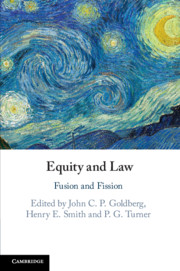Book contents
- Equity and Law
- Equity and Law
- Copyright page
- Contents
- Figures
- Table
- Contributors
- Acknowledgements
- Abbreviations
- Table of Cases
- Statutes
- 1 Fusion and Theories of Equity in Common Law Systems
- Part I Legal Systems and Legal Institutions
- Part II Fusion and Fission in Doctrine and Practice
- 9 Equity and the Common Counts
- 10 Mistake and Unfairness in Contract Law
- 11 Lex Sequitur Equitatem
- 12 Rediscovering the Equitable Origins of Discovery
- Part III Functional, Analytical and Theoretical Views
- Index
9 - Equity and the Common Counts
The Development of the Action for Money Had and Received
from Part II - Fusion and Fission in Doctrine and Practice
Published online by Cambridge University Press: 26 July 2019
- Equity and Law
- Equity and Law
- Copyright page
- Contents
- Figures
- Table
- Contributors
- Acknowledgements
- Abbreviations
- Table of Cases
- Statutes
- 1 Fusion and Theories of Equity in Common Law Systems
- Part I Legal Systems and Legal Institutions
- Part II Fusion and Fission in Doctrine and Practice
- 9 Equity and the Common Counts
- 10 Mistake and Unfairness in Contract Law
- 11 Lex Sequitur Equitatem
- 12 Rediscovering the Equitable Origins of Discovery
- Part III Functional, Analytical and Theoretical Views
- Index
Summary
What is the nature of a claim to recover restitution as money had and received? Lord Mansfield famously described the claim in terms of equity and conscience, which has led some to maintain that Mansfield fused elements of the common law with elements of equity. This chapter shows that no such thing occurred. Lord Mansfield took the scattered materials of the common law and provided them with a new unifying rationale. That rationale was conscience, but was not a borrowing from the equitable doctrines of the Court of Chancery: he rather developed the common law with concepts also seen in Chancery equity. And while some maintain that Mansfield borrowed from Roman law, that is also shown not to have happened. The upshot is that money had and received – the basic restitutionary remedy – is not a product of the fusion of law and equity, but is an independent development illustrating nothing about fusion.
Keywords
- Type
- Chapter
- Information
- Equity and LawFusion and Fission, pp. 203 - 228Publisher: Cambridge University PressPrint publication year: 2019
- 1
- Cited by

